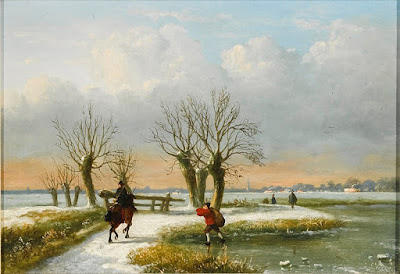_(6505647963).jpg) |
| "Badger by C. E. Swan (Meles taxus syn. Meles meles)" From: The wild beasts of the world (1909) by Frank Finn via Wikimedia Commons |
The Wind in the Willows first appeared in print in 1908. It's a beloved children's classic since then — I suspect that a plot summary isn't needed! Even aside from the books with Ernest H. Shephard's (or Arthur Rackham's, or...) illustrations, its legacy lives on in other ways.
My family watched the 1980s British stop motion animated series on Canadian television in the 1990s, and still sometimes hum the theme song from memory.
 |
| Mouse knitting From: Appley Dapply's Nursery Rhymes (1917) by Beatrix Potter via Wikimedia Commons |
The Wind in the Willows's Christmas passages, atmospheric and pleasingly English, have also inspired composer Audrey Snyder to arrange a musical setting of the Carol. It is sung by choirs at Christmas under the title "Joy on Christmas Morning." (For example: [YouTube].)
***
It was a pretty sight, and a seasonable one, that met their eyes when they flung the door open. In the fore-court, lit by the dim rays of a horn lantern, some eight or ten little fieldmice stood in a semicircle, red worsted comforters round their throats, their fore-paws thrust deep into their pockets, their feet jigging for warmth. With bright beady eyes they glanced shyly at each other, sniggering a little, sniffing and applying coat-sleeves a good deal. As the door opened, one of the elder ones that carried the lantern was just saying, 'Now then, one, two, three!' and forthwith their shrill little voices uprose on the air, singing one of the old-time carols that their forefathers composed in fields that were fallow and held by frost, or when snow-bound in chimney corners, and handed down to be sung in the miry street to lamp-lit windows at Yule-time.
CAROL
Villagers all, this frosty tide,Let your doors swing open wide,Though wind may follow, and snow beside,Yet draw us in by your fire to bide;Joy shall be yours in the morning!
Here we stand in the cold and the sleet,Blowing fingers and stamping feet,Come from far away you to greet—You by the fire and we in the street—Bidding you joy in the morning!
For ere one half of the night was gone,Sudden a star has led us on,Raining bliss and benison—Bliss to-morrow and more anon,Joy for every morning!
Goodman Joseph toiled through the snow—Saw the star o'er a stable low;Mary she might not further go—Welcome thatch, and litter below!Joy was hers in the morning!
And then they heard the angels tell'Who were the first to cry NOWELL?Animals all, as it befell,In the stable where they did dwell!Joy shall be theirs in the morning!'
 |
| "Belgian winter landscape" (19th century) by Louis-Pierre Verwee via Wikimedia Commons |
The voices ceased, the singers, bashful but smiling, exchanged sidelong glances, and silence succeeded—but for a moment only. Then, from up above and far away, down the tunnel they had so lately travelled was borne to their ears in a faint musical hum the sound of distant bells ringing a joyful and clangorous peal.
Source: The Wind in the Willows, by Kenneth Grahame [Project Gutenberg Australia]


No comments:
Post a Comment